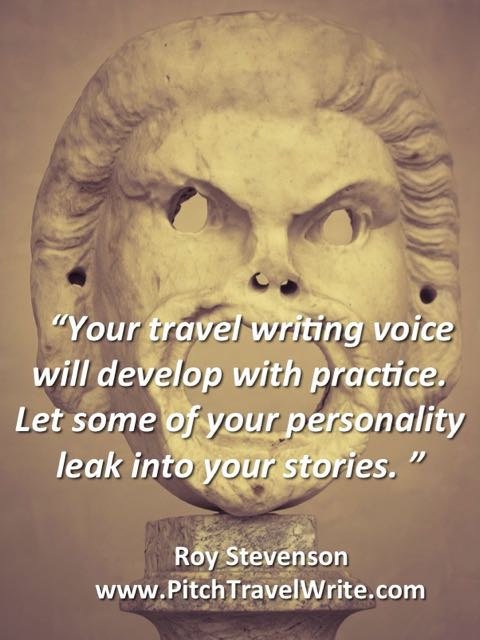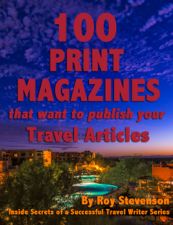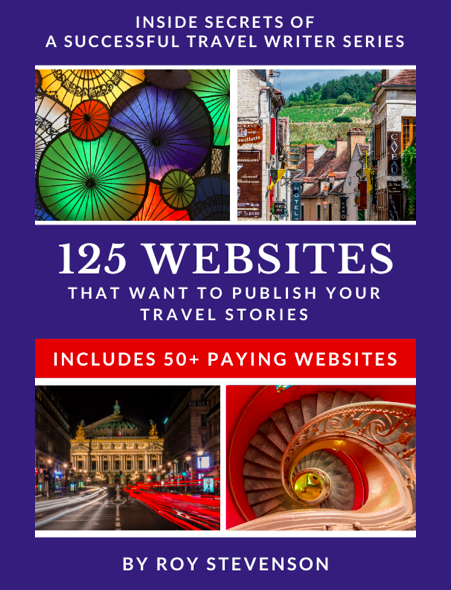- Home
- Travel Writing Craft Resources
- How to Write Like a Seasoned Professional
Travel Writing Craft Success:
10 Ways to Write
Like a Seasoned Professional
By Roy Stevenson
Your travel writing craft success depends almost entirely upon how well you can engage the reader in your story.
How many times have you picked up a travel magazine, scanned through the articles, and found yourself drawn into a story and completely absorbed in it?
And, how many times have you read the first few sentences of a travel article and then abandoned it from boredom?
Certainly, the beauty of a travel article is in the eye of the beholder. A travel story you enjoy may be boring to another reader—and vice versa.
Determining which travel topics are interesting is very subjective. I’ve read plenty of boring stories about Rome even though it’s one of my favorite destinations.
Yet I’ve been fascinated by stories about some rather mundane topics. Two articles come to mind that completely captivated me, yet were about topics that would seem at first glance destined for the travel story dumpster.
The first story was about a man on a train travelling from Thailand to Malaysia. It didn’t describe either place. Instead it told a story about the people he met on the train. The story was simple, yet memorable.
The second story that entranced me was about the daily duties and life of a private butler at an uber-upscale London hotel. Although I learned nothing about London, I was riveted by the description of the butler’s work: organizing birthday parties for rich children, hustling tickets to plays and sports events, purchasing clothes on Bond Street for a businessman - taking care of every whim of the bored but wealthy clientele. Great stuff!
Why did I enjoy these stories so much?
Both articles told stories. Humans love stories. And the stories flowed as if the writer was talking to me. I was compelled to read them through to the end.
It’s not necessarily what you are writing about but how you tell your story that makes it compelling.
Whether you’re writing for the Internet or for print, here are 10 techniques you can use to hone your travel writing craft:
Travel Writing Craft Success Tip #1:
Craft a Compelling Beginning
Many readers never get past the first paragraph because there’s nothing to hook them into the story. Your first few sentences are very important. If they start out like a travel advertorial, as so many do, many of your readers will yawn and go elsewhere.
Fortunately, there are a 101 great ways to start a travel article – so many that I can’t go into it here on this page. The Lonely Planet’s Travel Writing Guidebook by Don George is a good place to start for advice about the travel writing craft including some discussion about captivating beginnings. The book uses examples from some of the best travel writing they’ve published.
Travel Writing Craft Success Tip #2:
Use Quotes
 Here I am (on right) collecting quotes from the owner of the Gordon Estates Winery.
Here I am (on right) collecting quotes from the owner of the Gordon Estates Winery.You can bring your story to life if you use at least one set of quotes in every article. It could be an interesting character you met, or an expert on location.
Expressive, concise quotes liven up a travel story, so always have your notebook or recording device ready to capture what people are saying.
And if you can’t capture the exact words, it’s okay to use an approximation.
A more advanced form of quotes is the “structured dialogue”.
This is used when an important point doesn’t come across in a single quote. Instead, you can recreate your conversation in a series of quotes.
Travel Writing Craft Success Tip #3:
Use All Your Senses
The most common way to describe a scene is based on what we see. But the best travel writers take time to describe what they hear and smell, good or bad. Describing chaos and bedlam or the deathly silence of a place helps bring life to your story.
Taking it a step further and describing how something feels under your feet (cold, rough, slimy) or when you touch it (hot, steamy, thorny) brings alive the feelings and textures you experienced. The place becomes more tangible to the reader.
Describing your travel experiences using all of your senses will make your travel writing craft shine.
Travel Writing Craft Success Tip #4:
Weave in the Facts
Most stories need a few relevant facts about the destination to help define the place. Weave your facts seamlessly through the story to help describe the scene.
But don’t drop all the statistics in the same paragraph. You’ll come off sounding like an encyclopedia (or Wikipedia).
Travel Writing Craft Success Tip #5:
Paint a Picture with Your Words
This is one area where making beginner mistakes can hijack your article.
It’s important to describe your destination for the reader. But many beginning writers shovel heaps of adjectives and adverbs into a story, believing that too many descriptive words are better than too few.
The overall effect is somewhat like a cloying perfume. The artificial overdose detracts from the scene and repels us.
There’s a fine line between too many adjectives and too few. Painting too sparse a picture is the other extreme that stumps beginners.
Constantly examine your writing for overdone, flowery phrases that confuse and distract us from the story. When in doubt, leave out.
Travel Writing Craft Success Tip #6:
Develop Your Own Voice
How you tell a story will be different than how someone else tells the same story. Your perspective is unique .

Your travel writing craft will develop with practice, and your voice will develop, too. Let some of your personality leak into your stories, however you choose to do this.
For example, when it’s appropriate, I like to add an emotional or poignant feeling or experience into my stories. I’m not a bleeding heart, but when I see the opportunity to emotionally move my reader, I’ll go for it.
Here’s an example of an online
travel article where I used my writing to describe the powerful emotions
that I experienced when I visited the American Military Cemetery overlooking Omaha Beach at Normandy. Although some people might find this piece over-dramatic, I felt powerful emotions at the site, and thought it was important to convey them in the story.
It does take some courage to bare your soul, but in this case the feelings were far more important than simply describing the physical surroundings.
Travel Writing Craft Success Tip #7:
Vary Your Sentence Length
Some sentences are best short. Others, by necessity, must be longer. In most cases you want to stay away from overly long sentences. Point is, when we read we need a variety.
Having short and long sentences helps to vary the “cadence” or pace of a story. From a reader’s perspective, it speeds us up … or it slows us down.
Travel Writing Craft Success Tip #8:
Make Your Story Flow
To make your story readable, each paragraph should deliver you to the next one effortlessly, like riding a wave on a surfboard.
That means you need to pay attention to transitions from one paragraph to another. You transitions should be seamless. Each thought should flow into the next thought.
Your reader should feel gently guided from start to finish, rather than jolted between paragraphs and topics.
Travel Writing Craft Success Tip #9:
Cycle Back to the Beginning at the End
At the beginning of your article, you crafted your story to hook the reader. Don’t forget to cycle back to your beginning at the story’s conclusion. By doing this you wrap up your travel experience and bring closure to the story.
Abrupt endings that don’t pull together your opening thoughts with some conclusions leave your readers uneasy, and unfulfilled. Don’t leave them hanging at the end.
Cycling back to the beginning ties the story together. And as a writer, wrapping up your thoughts by circling back helps build a strong conclusion.
Travel Writing Craft Success Tip #10:
Entertain Your Reader with Your Travel Writing
Travel articles are read for enjoyment, and as a travel writer your job is to entertain. You want people to read your article and say, “That was a fun read!”
By telling stories, watching transitions and using these travel writing tips, your writing will look more professional.
Practice using these techniques in your articles. Not every technique will work with every article. But with some practice you’ll learn to write stories that your readers will be compelled to read through to the end. That’s the mark of a seasoned professional.
Do you struggle to craft an engaging story,
and wonder how to get past this barrier?

There are many tools and techniques you can learn. And they're not difficult!
If
you’re prepared to work on your writing style and make improvements,
you’ll get your stories published in highly respected, paying
publications.
The Art and Craft of Travel Writing is a handy reference with tips and techniques to help you.
More related articles that will interest you:
Creating a Sense of Place in Your Travel Stories
Using Statistics to Improve the Readability of Your Articles
4 Books that Will Help You Improve Your Writing

Roy Stevenson is a professional travel writer and the author of www.PitchTravelWrite.com. Over the past ten years, he’s had more than 1000 articles published in 200 magazines, trade and specialty journals, in-flights, on-boards, blogs and websites and has traveled on assignment around the U.S. and to dozens of international destinations.
IF YOU ENJOYED THIS POST, GET UPDATES. IT'S FREE.

















